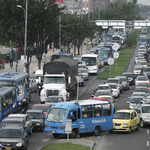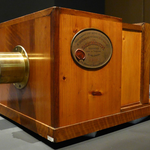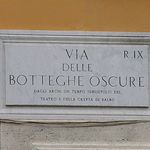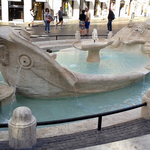Basilica di San Paolo Fuori Le Mura
The Basilica di San Paolo Fuori le Mura is the widest of roman patriarchal basilicas after San Pietro and its design has the same dimensions with Basilica Ulpia in Foro Traiano which can give us a perfect imagination about it.
It was Constantine that turned the "memory cell" of the Apostle into Basilica. The Basilica was consecrated in 324, then enlarged by Valentiniano II in 386 and by Teodosio and finally accomplished in a rich way by his son Onorio who became first emperor of the West.
It was a splendid basilica with five naves devided by 80 columns It contained a very rich interior with triumphal arch, with the transept and the apse lined of marbles, frescos and mosaics, and precious furnishings everywhere. Sisto V enriched it with a ceiling and Benedetto XII added the baroque porch.
By night on July 15 of1823 a fire damaged seriously the Basilica. Thanks to the donations of the believers Leo XII ordered architects Pasquale Belli, Pietro Bosio, Pietro Camporese,G. and Luigi Poletti to rebuild it. Unfortunately lots of parts of the ancient church were demolished and many frescos of Pietro Cavallini were lost.
The fire saved the ciborium of Arnolfo di Cambio, the Easter candle by Pietro Vassalletto and the apse mosaic of the IVth century. The elegant and enchanting cloister of the XII-XIII century which contains columns in a great variety of forms is also a work of Vassalletto.
Gregorio XVI consecrated the transept in 1840 and Pious IX consecrated all the Basilica in 1854. In the end of the century the Quadriporticus preceding the façade was constructed.
The basilica with the attached monastery is an extraterritorial property of Santa Sede.
The façade facing into the Tevere in the Via di San Paolo is preceded by a magnificent but stiff quadriporticus built between 1892 and 1928 by Guglielmo Calderini. The quadriporticus encloses pronaos of the façade (that means the external atrium of the church) with 10 monolith columns made of pink Baveno granite which are 10 meters high from one side and from the other side there are columns made of white Montorfano granite. The columns form the dual row on the sides and the triple row from the side of the Tevere. All in all there are 146 columns. At the centre of the quadriporticus is the big statue of San Paolo by Giuseppe Obici. In front of the façade's porch the statue of San Luca by Francesco Fabi-Altini stands.
Under the porch the statues to the Blessed Pietro and Pietro by Gregorio Zappalà rise up.
In the upper part of the façade by the design of Francesco Vespignani one can find the mosaics by a drawing of Filippo Agricola and Nicola Consoni.The medium door has the bronze shutters with bas- reliefs and with silver painting by Antonio Maraini (1930). The right-side door is walled and the left-side door appears to be la Porta Sacra from the internal part of which two "bronze shutters" of the ancient basilica's large door are put on. They are chiselled and silvered in a damask manner and have 54 panels decorated with scenes and characters from the Old and New Testament, symbols and inscriptions executed in Constantinople in 1070 by a certain Staurachio
di Scio by the order of archdeacon Ildebrando who was an abbot of San Paolo and then became Gregorio VII. They were considerably damaged by the fire of 1823 and then restored.
The interior of the current basilica has the dimensions and the form of the previous church: 131,66 meters long, 65 meters wide and 29,70 meters high. It has 80 monolith columns of Montorfano granite devided into five naves. The middle nave dominates over by the magnificent wideness of 24,60 meters. The coffered ceiling decorated by gilded ornaments bears a coat-of -arms of Pious IX.
On the upper part of the walls closed by slabs of Egyptian alabaster between big windows there are 36 frescos with the scenes from San Paolo's life. Underneath the wall the frieze extends to all the medium aisle.The side aisles contain portraits of all Popes beginning from San Pietro until modern days. Against the internal wall of the façade there are 6 big alabaster columns presented by Viceré Of Egypt for Gregorio XVI. Four of them were holding the canopy which covered the ciborium of Arnolfo di Cambio.

 The records of Rome. Big numbers, not always enviable, for a big city.
The records of Rome. Big numbers, not always enviable, for a big city. New Phot-O-Matic section. To spend some time looking at photos (also) of Rome.
New Phot-O-Matic section. To spend some time looking at photos (also) of Rome. The administrative, urban, toponymic and imaginative subdivisions of Rome.
The administrative, urban, toponymic and imaginative subdivisions of Rome. Notice for tourists: in Rome you drink for free. Historical fountains and 'big noses'.
Notice for tourists: in Rome you drink for free. Historical fountains and 'big noses'. Free museums return on the first Sunday of the month.
Free museums return on the first Sunday of the month.